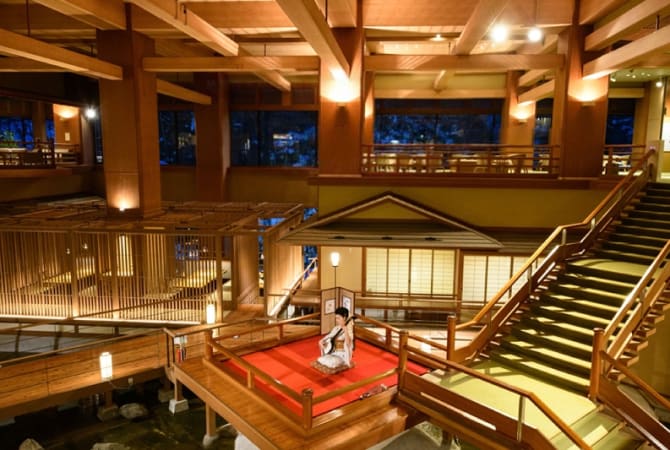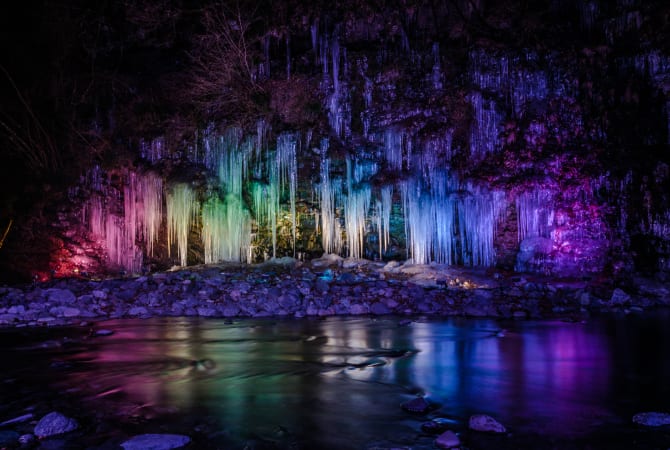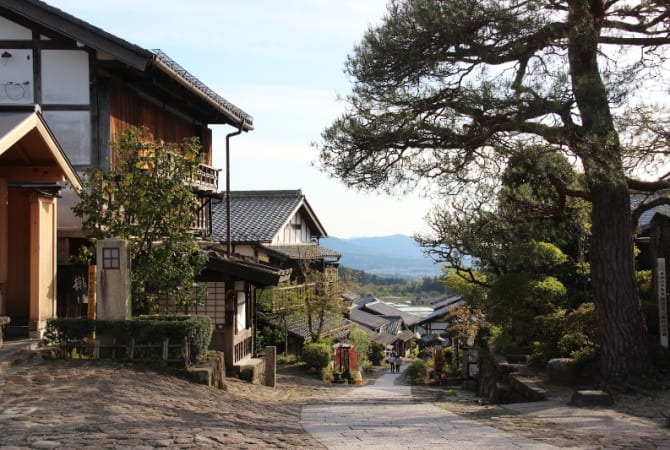Winter Snaps: Discover These 5 Picture-Perfect Winter Destinations In Japan
Japan is stunning all year round, with its scenery arresting and picturesque in its natural splendor through the seasons. Visit during any month and you are bound to find stunning landscapes to feast your eyes on. Be that as it may, it’s in winter when places in Japan transform into scenes of otherworldly beauty and mystique. The snow caps, crisp air, and fantasy-like atmosphere create a uniquely joyful experience.
Here, we list down five Instagram-worthy winter destinations in Japan for a preview of what awaits you during the colder months in this beautiful country!
P.S. Read until the end, and join our Read & Win Contest to stand a chance to win a prize from Japan!
1. Enjoy stunning views of snow-capped mountains from Tadami River Bridge No. 1 Viewpoint in Fukushima

The Tadami River, along with the Tadami River Bridge No.1, is perhaps one of the most iconic landmarks in Mishima Town, Fukushima Prefecture. After all, it presents a postcard-perfect scene that feels idyllic in every season. The river is surrounded by picturesque multicolored leaves during autumn, and when winter comes, the trees and landscape glisten with snow.
The Tadami River Bridge is part of the Tadami Line, which stretches between Aizu-Wakamatsu Station in Fukushima and Koide Station in Niigata. This 135-kilometer route is marked by breathtaking landscapes, including those along the Tadami River.
You can enjoy the best views of the Tadami River Bridge No. 1 from the Tadami River Bridge No. 1 Viewpoint, which is around a ten-minute walk from Michi-no-Eki Ozekaido Mishima-juku, a roadside stop where you can find snacks and souvenirs, including local crafts. On a calm winter day, the arch bridge is reflected in the peaceful water below, creating a fascinating scene.
Tadami River Bridge No. 1 Viewpoint (Website)
Address: Kawai, Mishima-machi, Onuma District, Fukushima Prefecture 969-7515
Access: From Tokyo Station, take the Tohoku Shinkansen line to Koriyama Station. From there, you can ride the Banetsu West Line to Aizu-Wakamatsu Station, where the Tadami Line begins. The Tadami River Bridge No.1 Viewpoint at Mishima-juku is a short bus ride from Aizu-Miyashita Station. For a more detailed guide, visit this page.
2. Explore and dine in the winter wonderland of Iiyama Kamakura Village in Nagano

Photo Credit: Shinshu-Iiyama Tourism Bureau
Have you ever wondered what it would be like to live in an igloo — or at least dine in one? Well, you can do the latter at Restaurant Kamakura Village, located in Iiyama City, Nagano Prefecture.
The village, set against snow-mantled mountains, consists of 20 “kamakura”, or snow domes. Dining guests can enjoy lunch or dinner in the huts, with a meal centered around Noroshi Nabe, an Iiyama specialty hot pot made with Shinshu miso, IIyama’s own Miyuki Pork (with vegetarian and halal options available), locally grown vegetables, and mushrooms. Afternoon snacks can also be enjoyed in the igloos, including roasted sweet potatoes and oshiruko (a sweet red bean soup) or amazake (a non-alcoholic drink made from fermented rice). At night, lanterns illuminate the kamakura, enhancing their charm.
This enchanting collection of snow domes is open to the public for only a limited time each year, from late January to late February, given the nature of the structures. With this short window, dining in the huts is by reservation only. However, it is still open for entry to those who just want to see the huts and other sights.
During the second week of February, the village also holds the Kamakura Festival, which features live music, fireworks displays, snow games, snowshoe hikes, hut-making activities, and other festivities.
You May Also Like
Restaurant Kamakura Village (Website)
Address: Shinanodaira Kamakura Village, 807-2 Kotobuki, Iiyama City, Nagano Prefecture 389-2418
Access: From Tokyo Station, take the Hokuriku Shinkansen to Iiyama Station. From there, Kamakura Village is 11 minutes away by short bus or taxi.
Operating Hours:
- In 2025, Restaurant Kamakura Village will be open from January 24 - February 28.
- Saturdays, Sundays, and holidays:
- Lunch time: 11:00 a.m. to 12:30 p.m. / 1:15 p.m. to 2:45 p.m.
- Dinner time: 4:30 p.m. to 5:45 p.m. / 6:30 p.m. to 7:45 p.m. ※Hotel plan only
- Weekday
- Lunch time: 11:00 a.m. to 12:30 p.m. / 1:15 p.m. to 2:45 p.m.
- Dinner time: 6:00 p.m. to 7:30 p.m.
- Advance reservation is required for those who want to dine inside the snow huts.
Admission:
- For non-dining visitors: Adult: JPY200; Children: JPY100 (Free for preschoolers) (*Note that this is just the entry fee. Other fees may vary depending on the plan you want to reserve.)
- The fee is waived for those dining in the huts.
3. Marvel at the stunning, historic village of Gokayama in Toyama

Gokayama - Ainokura Vilage
Photo Credit: Toyama Prefecture, Toyama Tourism Promotion Organization
Located in Nanto City, Toyama Prefecture, the secluded area of Gokayama is characterized by clusters of houses whose thatched roofs resemble hands held together and lifted in prayer. This architectural style – gassho-zukuri – was derived from this gesture in Buddhism, called gassho.
As you can imagine, Gokayama in winter looks straight out of a fairy tale with these unique dwellings. What’s more, these traditional houses, tucked away in Gokayama’s remote hamlets of Ainokura and Suganuma, are between 100 to 400 years old. Because of these awe-inspiring well-preserved houses and their history, Ainokura and Suganuma villages are on UNESCO’s World Heritage list. Ogi-machi Village in Shirakawa-go in Gifu Prefecture is also on the list for the same reason.

Gokayama - Suganuma Vilage
Photo Credit: Toyama Prefecture, Toyama Tourism Promotion Organization
The houses were designed in response to the heavy snowfall the areas receive; the steep angles of the roofs allow snow to slip off easily. The roofs are re-thatched every few decades, depending on need. While some houses remain residences, others are private houses that operate as lodging facilities, offering visitors the rare experience of staying in a World Heritage Site.
Gokayama offers a range of activities amid its stunning winter scenery. Visitors can try alpine skiing and cross-country, or unwind in the region’s hot springs. For a hands-on experience, they can also try making washi paper, a traditional craft of the area.
A highlight in the place is the annual Gokayama Winter Light-up, where the traditional thatched-roof houses are illuminated, creating a stunning display. This is only held a few days a year, and for 2025, the Suganuma Village light-up will take place on January 26 and February 1 and 2, while the Ainokura Village light-up is set to happen on February 22 and 23. There’s also a Window Light-up viewing where visitors can enjoy the view of the village when the window lights are lit at night, it’s scheduled on January 8, 15, 22, and 29.
Gokayama (Website)
Address: Ainokura, Nanto City, Toyama Prefecture 939-1915 / Suganuma, Nanto City, Toyama Prefecture 939-1973
Contact Details:
- Gokayama General Information Center (Kanashi Village)
- Email: mail@gokayama-info.jp
Access: From Tokyo Station, take the Hokuriku Shinkansen to Shin-Takaoka Station. From there, take the World Heritage Bus, get off at Ainokuraguchi, and take a 7-minute walk from the bus stop to Ainokura Village. Then, 15-minutes away from there, you can also get off at Suganuma and reach Suganuma Village on foot.
Operating Hours:
- Ainokura Village: 8:30 a.m. to 5:00 p.m.
- Suganuma Village: 9:00 a.m. to 4:00 p.m.
- Visit the official website for the official hours of the Winter Light-up Events.
4. Strike a pose and be in awe of the beauty of Kenrokuen Garden in Ishikawa

In Ishikawa Prefecture’s capital city of Kanazawa sprawls the magnificent Kenrokuen Garden. One of the Three Great Gardens of Japan, along with Kairakuen Garden in Ibaraki Prefecture and Korakuen Garden in Okayama Prefecture, Kenrokuen covers a land area of 11.4 hectares, filled with trees and different plant species. The garden’s name, given in 1822 by the feudal lord Matsudaira Sadanobu, means “garden that combines six attributes,” which are spaciousness, seclusion, artifice, antiquity, waterways, and panoramas. Very few gardens in Japan have all these six attributes - making Kenrokuen a truly remarkable garden.
Kenrokuen Garden was created for the Maeda clan by Lord Maeda, the fifth lord of the Kaga Domain, who built a villa on a slope within Kanazawa Castle grounds and transformed the surrounding area into a garden. The construction spanned for over two centuries, beginning with the Renchitei Garden in 1676. Originally private, the garden was opened to the public in 1874. Aside from the garden itself, some highlights of this place include several tea houses, pagodas, and the large Kasumiga-ike Pond, which features a naturally occurring fountain at one corner.

Kenrokuen Garden, as one can imagine, is lovely all year round. However, a unique feature that awaits visitors during winter is the umbrella-shaped contraption suspended above the pine trees. This technique, called yukitsuri, is used to support the trees’ branches and prevent them from collapsing under the weight of snow. It entails ropes held up over a tree by a pole and then tied to the branches, forming a circular shape around the tree. Though primarily a utilitarian mechanism, the resulting conical shapes are indeed a sight to behold.
Kenrokuen Garden (Website)
Address: 1 Kenroku-machi, Kanazawa City, Ishikawa Prefecture 920-0936
Access: From Osaka Station, take the JR West Line and alight at Tsuruga Station. From there, ride the Hokuriku Shinkansen to Kanazawa Station. Then, take a 20-minute bus ride to Kenrokuen Garden.
Operating Hours:
- March 1 to October 15: 7:00 a.m. to 6:00 p.m.
- October 16, 2024 to the end of February 2025: 8:00 a.m. to 5:00 p.m.
Admission: Adult: JPY320, Children: JPY100
5. Snap aesthetic photos of the magical winter scenery at Gujo Hachiman Castle

Photo Credit: Gujo Hachiman Castle @ 春木 悦代
Sitting on top of Hachiman Mountain in Gujo City in Gifu Prefecture, Gujo Hachiman Castle is an example of a Yamashiro, or mountain castle. Owing to its position, it commands a stunning view of the valley below, especially during autumn. However, during winter, snow bestows the castle with an aura that feels almost magical.
The old fortress, defended by two rivers and the mountain, was built in 1559 by Endo Morikazu. Much of the castle was torn down in 1872, in the early Meiji period, when feudalism was abolished and prefectures were established. Only the castle’s inner moats and stone walls were spared.
In 1933, the castle was rebuilt with wood instead of concrete, which was often the chosen material for castle restoration. The original stone walls of Gujo Hachiman have since been designated as important historical properties of Gifu Prefecture.
Gujo Hachiman Castle (Website)
Address: 659 Ichinohira, Yanagi-machi, Hachiman-cho, Gujo City, Gifu Prefecture 501-4214
Access: From Nagoya Station, take the Nagaragawa Railway to Gujo Hachiman Station. Then, take a short bus ride to the Joka-machi Plaza bus stop. From there, walk 20 minutes to Gujo Hachiman Castle.
*Note: No public transportation is available going up to the castle.
Operating Hours:
- March to May; September to October: 9:00 a.m. to 5:00 p.m.
- June to August: 8:00 a.m. to 6:00 p.m.
- November to February: 9:00 a.m. to 4:30 p.m.
Admission: Adult: JPY320, Children: JPY150
Winter in Japan is truly magical and full of adventure! Which of these stunning destinations will you explore during this season?
Discover more of Japan. Follow us on Facebook and Instagram for fun facts and quick tips about Japan.
Read & Win! Exciting Prizes from Japan
Stand a chance to win exciting prizes from Japan! Head over here to know how you can join.



















































